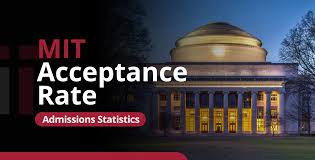MIT Acceptance Rate, Massachusetts Institute of Technology (MIT) stands as a beacon of innovation and academic excellence. Renowned for its cutting-edge research, brilliant faculty, and groundbreaking contributions to science and technology, MIT is a top choice for students aiming to make a significant impact in their fields. Yet, alongside its allure comes a challenging reality: its acceptance rate. Understanding MIT’s acceptance rate provides crucial insights into the admissions process and helps prospective students navigate their applications with greater clarity. In this article, we will explore MIT’s acceptance rate, the factors influencing it, and what it means for aspiring applicants.
History of MIT Acceptance Rate
To appreciate the current state of MIT acceptance rate, it’s helpful to look back at its history. Founded in 1861, MIT initially focused on providing a practical education in science and engineering. In its early years, the university had a relatively high acceptance rate due to its niche focus and limited recognition.
However, as Massachusetts Institute of Technology reputation grew, so did the number of applications. The university’s commitment to research and innovation attracted top students from around the world, leading to a more competitive admissions process. By the early 2000s, MIT’s acceptance rate began to decline significantly. For instance, in 2000, the acceptance rate was approximately 17%. Fast forward to the 2020-2021 admissions cycle, and MIT’s acceptance rate had dropped to a mere 4.0%.
Comparing Massachusetts Institute of Technology acceptance rate with other top universities highlights its selectivity. For example, while Ivy League schools like Harvard and Princeton also have low acceptance rates, MIT often ranks as one of the most competitive institutions in terms of admissions. This extreme selectivity underscores MIT’s status as a leading global institution and reflects the growing number of highly qualified applicants.
Factors Influencing MIT Acceptance Rate
Several key factors contribute to MIT’s low acceptance rate. Understanding these factors provides valuable insights for prospective students and helps them better prepare for the admissions process.
Surge in Applications
One of the primary drivers of MIT’s low acceptance rate is the increasing number of applications. Each year, thousands of students from across the globe apply to MIT, seeking a place in its esteemed programs. In the 2021-2022 admissions cycle, MIT received over 34,000 applications, a significant increase from previous years.
This surge in applications can be attributed to several factors. MIT’s reputation as a leader in STEM (Science, Technology, Engineering, and Mathematics) fields draws top talent from all corners of the world. Additionally, the ease of applying through platforms like the Common Application has made it simpler for students to apply to multiple prestigious institutions, leading to a higher volume of applications.
Moreover, the COVID-19 pandemic led to a shift in admissions policies, including test-optional options. Many students who might have been deterred by standardized testing requirements chose to apply to MIT, further increasing the application pool.
The growing number of applications means that MIT must be more selective in its admissions process. With so many highly qualified candidates, the university can only admit a small percentage, leading to a lower acceptance rate.
Holistic Admissions Process
MIT employs a holistic admissions process, evaluating applicants on a range of criteria beyond just grades and test scores. This approach allows MIT to assess a student’s overall potential, including their intellectual curiosity, creativity, and problem-solving skills.
While academic excellence remains a critical factor, MIT places significant emphasis on other aspects of the application. This includes extracurricular activities, personal essays, and letters of recommendation. The admissions committee looks for students who demonstrate exceptional talent, leadership, and a passion for making a difference in their fields.
Additionally, MIT values innovation and creativity. Applicants who showcase their ability to think outside the box and tackle complex problems are often viewed favorably. This holistic approach not only makes the admissions process more competitive but also reflects MIT’s commitment to fostering a diverse and dynamic student body.
Focus on STEM
MIT’s strong emphasis on STEM disciplines plays a crucial role in shaping its acceptance rate. As a leading institution in engineering, technology, and scientific research, MIT attracts students with a keen interest in these fields. The university’s programs are designed to challenge and inspire students who are passionate about pushing the boundaries of knowledge.
The focus on STEM subjects means that MIT often receives applications from students who excel in mathematics, science, and engineering. This specialization contributes to the university’s low acceptance rate, as it narrows the pool of applicants who meet the rigorous academic and intellectual standards.
Furthermore, Massachusetts Institute of Technology commitment to advancing technology and research often leads to the development of cutting-edge projects and initiatives. Students who demonstrate a strong aptitude for these areas are more likely to stand out in the admissions process, further driving the university’s selectivity.
MIT’s Global Reputation
MIT’s global reputation as a top-tier institution significantly impacts its acceptance rate. The university is renowned for its groundbreaking research, influential faculty, and vibrant campus community. This reputation attracts talented students from around the world who aspire to be part of MIT’s prestigious programs.
The university’s location in Cambridge, Massachusetts, near the tech hub of Boston, also enhances its appeal. Students are drawn to MIT’s proximity to numerous technology companies, research centers, and innovation hubs. This global recognition and geographic advantage contribute to the high volume of applications and the university’s competitive admissions process.
Moreover, MIT’s international collaborations and partnerships further bolster its global standing. The university’s involvement in global research projects and initiatives reinforces its reputation as a leader in technology and innovation. As a result, students from diverse backgrounds and regions are eager to apply to MIT, knowing that it offers unparalleled opportunities for academic and professional growth.
Implications for Prospective Students
For prospective students, understanding MIT’s acceptance rate and the factors influencing it is essential for navigating the admissions process effectively. While the competition is intense, there are strategies and approaches that can enhance an applicant’s chances of success.
Challenges for Applicants
The primary challenge for applicants is the high level of competition. With a low acceptance rate and a large number of highly qualified candidates, standing out in the admissions process can be daunting. Many applicants have exceptional academic records, strong test scores, and impressive extracurricular achievements.
Additionally, the holistic admissions process means that students must excel in multiple areas, including academics, leadership, and personal qualities. This multifaceted evaluation can make it challenging for applicants to present a well-rounded and compelling application.
Another challenge is the emphasis on STEM subjects. While MIT is open to students from various disciplines, the university’s focus on STEM means that applicants with a strong background in these areas may have an advantage. Students who do not have a background in STEM but are passionate about the field may need to work harder to demonstrate their commitment and potential.
Application Strategy
To improve their chances of admission, prospective students should focus on crafting a strong and authentic application. Here are some key strategies to consider:
1.Highlight Unique Strengths: Emphasize any unique achievements, projects, or experiences that set you apart from other applicants. MIT values creativity and innovation, so showcasing your ability to think outside the box can be advantageous.
2.Excel Academically: While MIT evaluates applicants holistically, strong academic performance remains crucial. Maintain a high GPA and excel in challenging coursework, particularly in STEM subjects.
3. Prepare Thoughtful Essays: Use your personal essays to provide insight into your passions, goals, and experiences. Be genuine and reflective, and demonstrate how you align with MIT’s values and mission.
4. Seek Strong Recommendations: Obtain letters of recommendation from individuals who can speak to your strengths, achievements, and potential. Choose recommenders who know you well and can provide detailed, personalized insights into your abilities and character. Ideally, these should be teachers or mentors who have witnessed your academic and extracurricular endeavors firsthand.
5. Showcase Extracurricular Involvement: MIT looks for students who are actively engaged in their communities and have demonstrated leadership and initiative. Highlight your involvement in clubs, organizations, or projects that reflect your interests and contributions. Whether it’s starting a nonprofit, leading a research project, or participating in a significant competition, make sure your extracurricular activities align with your academic goals and passions.
6. Consider an Early Action Application: Applying through MIT’s Restrictive Early Action program can be advantageous if you’re confident in your application. This early application option allows you to demonstrate your strong interest in MIT without committing to attend if admitted. However, be aware that the competition in the Early Action pool remains intense, and ensure that your application is thoroughly prepared.
Realistic Expectations
Given MIT’s low acceptance rate, it’s crucial for applicants to have realistic expectations. While aiming for MIT is commendable, it’s important to build a balanced college list that includes a mix of reach, match, and safety schools. This approach ensures that you have a range of options and reduces the stress associated with the admissions process.
It’s also beneficial to focus on finding schools that align with your academic interests, personal values, and career goals. MIT is an exceptional institution, but many other colleges and universities offer outstanding opportunities for learning and growth. Keeping an open mind and exploring various options will help you find a college that fits your needs and aspirations.
The Future of MIT’s Acceptance Rate
As we look to the future, several trends may influence MIT’s acceptance rate. While it’s challenging to predict exact changes, understanding these potential trends can provide insights into how the admissions landscape may evolve.
Potential Trends
1.Increased Application Volume: The trend of rising applications is likely to continue, driven by MIT’s global reputation and the increasing number of students applying to multiple top-tier universities. As more students from diverse backgrounds seek admission to MIT, the acceptance rate may experience further declines.
2. Changes in Admissions Policies: MIT may continue to adapt its admissions policies in response to broader educational trends. For example, the test-optional movement, which emerged during the COVID-19 pandemic, could influence MIT’s approach to standardized testing. The university might explore new ways to evaluate applicants or emphasize different aspects of the application.
3. Focus on Diversity and Inclusion: MIT’s commitment to diversity and inclusion is expected to remain a priority. The university will likely continue to seek students from a wide range of backgrounds and experiences, contributing to a diverse and dynamic campus community. This focus may impact the admissions process and acceptance rate, as MIT strives to balance excellence with representation.
4. Evolving Academic and Research Priorities: As MIT continues to push the boundaries of research and innovation, its academic and research priorities may shift. This evolution could influence the types of students MIT seeks to admit and the qualities it values in applicants.
MIT’s Adaptation to Change
MIT is known for its ability to adapt and innovate, and its admissions process is no exception. As the university navigates these potential trends, it will likely continue to refine its approach to selecting students. MIT’s emphasis on academic excellence, creativity, and impact will remain central to its admissions criteria.
The university may also explore new methods for evaluating applicants, such as incorporating interviews or alternative assessments. By staying responsive to changes in the educational landscape, MIT will strive to maintain its high standards while accommodating the evolving needs of students and society.
ALSO READ: Stanford University Acceptance Rate 2024
Conclusion
In summary, MIT’s acceptance rate reflects its position as one of the most prestigious and competitive institutions in the world. The low acceptance rate, driven by factors such as a surge in applications, a holistic admissions process, and MIT’s global reputation, presents significant challenges for prospective students. However, understanding these factors and adopting effective application strategies can enhance your chances of success.
As you prepare for the admissions process, focus on presenting your unique strengths, excelling academically, and exploring a variety of college options. Remember that while MIT is an exceptional institution, many other universities offer outstanding educational opportunities. By keeping an open mind and pursuing your passions, you’ll be well-equipped to navigate the college admissions process and achieve your academic and career goals.
Additional Resources
For more information on MIT’s admissions process, visit the [MIT Admissions] page. For guidance on crafting a compelling college application essay, check out this [college essay writing guide]. If you have specific questions about MIT’s acceptance rate and admissions process, consider exploring forums or reaching out to current students or alumni for insights.
Discover more from
Subscribe to get the latest posts sent to your email.



